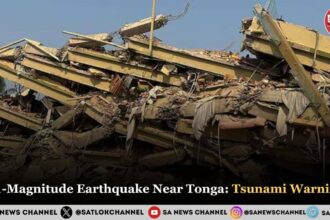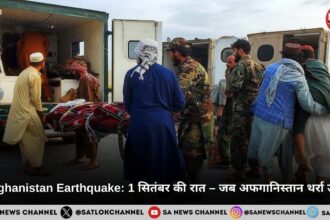On March 28, 2025, a powerful earthquake measuring 7.7 on the Richter scale struck central Myanmar, with its epicenter in the Sagaing region. The tremors were felt across Southeast Asia, causing widespread panic and destruction in neighboring Thailand and beyond. This catastrophic event resulted in collapsed buildings, loss of lives, and left thousands displaced.
- 1. The Magnitude and Impact of the Earthquake
- 2. Casualties and Immediate Reactions
- 3. Rescue Operations and International Support
- 4. The Role of Preparedness and Resilience
- 5. Efforts to Rebuild and Support Affected Communities
- 6. Lessons Learned for the Future
- Conclusion: Strengthening Resilience for Tomorrow
As emergency services continue rescue efforts, this disaster serves as a grim reminder of nature’s unpredictable fury and highlights the urgent need for disaster preparedness and global cooperation.
1. The Magnitude and Impact of the Earthquake
The 7.7-magnitude earthquake had its epicenter in Sagaing, Myanmar, a region known for its seismic activity due to the interaction of the Indian and Eurasian tectonic plates. The tremors were powerful enough to be felt hundreds of kilometers away, affecting major cities such as Bangkok, Thailand, where residents experienced intense shaking.
- Impact on Myanmar: Entire neighborhoods in Sagaing were flattened, with key infrastructures such as bridges, schools, and hospitals suffering extensive damage. Historical monuments and temples also crumbled under the seismic pressure.
- Destruction in Thailand: Bangkok, a densely populated metropolis, witnessed widespread panic as several high-rise buildings developed dangerous cracks, and one residential tower collapsed, trapping residents inside. The tremors also caused disruptions to public transport and power outages in several areas.
2. Casualties and Immediate Reactions
The human cost of the earthquake has been devastating, with hundreds of casualties reported in both countries.
- Bangkok’s Tragedy: In Thailand, at least 75 people lost their lives, with over 250 individuals injured due to the collapse of a high-rise building in downtown Bangkok. Several others remain trapped under the debris, prompting an all-out rescue effort.
- Myanmar’s Toll: Myanmar’s casualty figures are even more alarming, with over 300 fatalities reported so far and thousands displaced. Reports of collapsed buildings and damaged infrastructure have overwhelmed local authorities.
In response to the disaster, the Thai government declared a state of emergency, mobilizing the army and local authorities to assist with evacuation and rescue efforts. The Myanmar government has appealed for international assistance, recognizing the scale of the disaster.
■ Also Read: 5.8 Magnitude Earthquake Hits Pakistan; Tremors Felt In Northern India Including Delhi
3. Rescue Operations and International Support
As chaos unfolded, rescue teams from Thailand, Myanmar, and neighboring countries swiftly mobilized to assist affected regions.
- Thailand’s Response: In Bangkok, specialized rescue teams and firefighters worked tirelessly to rescue those trapped in the collapsed high-rise. Medical teams established makeshift field hospitals to provide immediate aid to the injured.
- Myanmar’s Challenge: Myanmar’s rescue efforts faced logistical challenges due to damaged roads and limited resources. However, the Myanmar military and volunteer groups joined forces to search for survivors and provide emergency relief.
International Support
The international community has shown solidarity in the wake of this catastrophe:
- India: The Indian government swiftly dispatched humanitarian aid, including medical supplies, food, and rescue teams to assist affected areas.
- ASEAN Nations: Neighboring countries such as Malaysia, Indonesia, and the Philippines pledged support by sending search and rescue teams.
- UN and NGOs: International organizations such as the United Nations and the Red Cross coordinated efforts to provide food, water, and shelter to those displaced.
4. The Role of Preparedness and Resilience
This disaster highlights the critical importance of disaster preparedness in minimizing loss and ensuring faster recovery.
- Early Warning Systems: Investing in advanced seismic monitoring and early warning systems can provide valuable seconds or minutes for people to seek safety.
- Building Safety Regulations: Implementing and enforcing stricter building codes can significantly reduce the risk of collapses during earthquakes.
- Community Awareness Programs: Educating communities about evacuation protocols, first aid, and safe practices can empower people to respond effectively in emergencies.
5. Efforts to Rebuild and Support Affected Communities
As the immediate rescue phase transitions into recovery, rebuilding efforts have begun in the affected areas.
- Restoring Infrastructure: Governments in both Thailand and Myanmar have prioritized restoring critical infrastructure such as electricity, water supply, and transportation networks.
- Supporting Displaced Communities: Relief camps have been set up to provide food, shelter, and medical care to displaced families. Mental health professionals have been deployed to help survivors cope with trauma.
India’s Support for Its Citizens
The Indian Embassy in Thailand and Myanmar has been proactive in ensuring the safety of Indian nationals caught in the disaster. Helplines have been established, and stranded citizens are being provided with assistance to return home safely.
6. Lessons Learned for the Future
The tragedy serves as a wake-up call for nations prone to seismic activity, emphasizing the need for improved disaster management systems.
- Stronger Coordination: Regional collaboration between Southeast Asian nations can enhance the effectiveness of disaster response and resource sharing.
- Investment in Preparedness: Increased funding for disaster preparedness, including training first responders and upgrading infrastructure, can save lives in future emergencies.
- Public Participation: Engaging communities in disaster preparedness initiatives ensures that people at the grassroots level are equipped to respond effectively.
Conclusion: Strengthening Resilience for Tomorrow
The devastating earthquake in Thailand and Myanmar has left a trail of destruction and grief, but it has also highlighted the resilience of affected communities and the importance of global solidarity in times of crisis.
As countries rebuild and heal, there is an urgent need to strengthen disaster preparedness, invest in resilient infrastructure, and foster international cooperation. Only by learning from this tragedy can we ensure a safer and more prepared future for all.
Sant Rampal Ji Maharaj emphasizes that natural disasters like earthquakes are reminders for humanity to reflect on their actions and follow the true path of devotion. According to His teachings, true devotion to the Supreme God as described in Holy Scriptures can protect individuals from suffering and grant eternal peace.
Sant Rampal Ji Maharaj explains that by following the correct spiritual path, as mentioned in Bhagavad Gita and Kabir Sahib’s teachings, one can escape the cycle of birth, death, and disasters. This tragedy serves as a reminder to seek the shelter of the Supreme God for ultimate safety.









